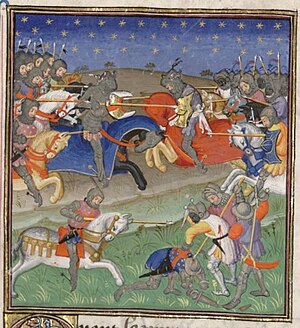Battle of Teba
| date | August 25, 1330 |
|---|---|
| place | Teba , Andalusia |
| output | Victory of the Christians |
| Parties to the conflict | |
|---|---|
| Commander | |
| Troop strength | |
| unknown | unknown |
| losses | |
|
unknown |
unknown |
The Battle of Teba took place on August 25, 1330, below the Castello de la Estrella, Teba , Andalusia . The battle was part of the dispute between King Alfonso XI. of Castile-Leon and Emir Muhammad IV of Granada from 1312 to 1350.
prehistory
King Alfonso invited knights from all over Europe to take part in his fight against the Nasrids. James Douglas , friend and officer of the Scottish King Robert Bruce († 1329), was commissioned to take Robert's embalmed heart with him on a pilgrimage to the Holy Land . Douglas and a group of other knights reached Seville in late July .
The battle
On the morning of August 25th, the Moorish army gathered below the Castello de la Estrella.
The Castilians sounded their horns and Douglas, commanding one flank of the Christian army, believed the attack was about to begin, and the Scots began to attack the Moors . The Castilians did not follow, however, and the Scots were quickly surrounded and almost all of them killed. Muhammad ordered his cavalry (3,000 men) to carry out a mock attack on the Spaniards, while he tried to stab Alfons in the back with the main force via a secret route at his headquarters. Alfons, however, apparently knew the Moors' plan and held back his main force while he was able to withstand the enemy cavalry attack. The Spaniards soon gained the upper hand and conquered the Castello de la Estrella from the Moors. King Alfons handed the castle over to the Santiagoorden .
consequences
Douglas' body and his King's heart were brought back to Scotland together and he was buried in St Bride's Church in South Lanarkshire .
The battle was not of decisive military importance, but it made Muhammad IV think that he needed help from the Sultan of Morocco Abu l-Hasan . By joining forces, the Muslims were able to conquer Gibraltar in 1333 . However, after the Moorish defeat at the Battle of the Salado in 1340, the interventions from North Africa ended, so that the emirate of Granada was the last independent Islamic state on the Iberian Peninsula to be on its own. It lasted until the fall of Granada in 1492.
swell
- Michael Brown: The Black Douglases. War and Lordship in Late Medieval Scotland. Tuckwell Press, East Linton 1998, ISBN 1-86232-036-5 .
- David Hume of Godscroft: The History of the House of Douglas and Angus. Scottish Text Soc., Edinburgh 1996 (reprint of the London 1820 edition).
- Volume 1, ISBN 1-897976-12-7 .
- Volume 2, ISBN 1-897976-13-5 .
- Herbert E. Maxwell: History of the House of Douglas. From the earliest times down to the legislative union of England and Scotland . Freemantle, London 1902 (2 vols.).
- John Anderson: Sir James Douglas, Lord of Douglas . In: James Balfour Paul (Ed.): The Scots Peerage . tape 3 : Crawford – Falklands . David Douglas, Edinburgh 1906, p. 142–146 (English, Textarchiv - Internet Archive ).
Web links
- Page about the Castello de la Estrella (Spanish)
- "Black" Douglas y la Batalla de Teba ( Memento from August 29, 2008 in the Internet Archive ) (Spanish)
